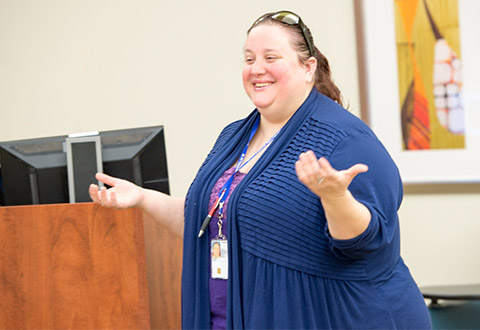VHA National Center for Patient Safety
Making a Difference: Patient Safety Fellows

Angela Stabryla discusses issues concerning wandering and missing patients with senior medical center officials.
Preventing patients from wandering or becoming missing from VA facilities and grounds is a challenge faced by VA caregivers around the nation.
“It’s a problem that I felt was an important area to focus upon during my patient safety fellowship,” said Angela Stabryla, M.P.M., a fellow at the VA Pittsburgh Healthcare System.
Stabryla was tasked to rewrite the facility’s wandering and missing patients event memorandum, known as the “When Minutes Matter” policies, and co-chair a related “At-Risk Task Force.”
“I was also asked to author a continuing education module for VA Learning University’s Talent Management System,” she said.
Learning goals of the module included showing how dementia or traumatic brain injury can increase the risk for wandering.
“It was important that the module defined the difference between missing, absent and wandering patients, too,” she added, “so that the proper course of action can be taken, which is very important to leadership.”
“People can be identified as absent when missing and visa versa,” Stabryla continued. “It can lead to tragic consequences, because if someone is missing, but designated as absent, it means we are not looking for them.”
As part of her fellowship, she has also had an opportunity to work on an aggregate Root Cause Analysis (RCA).
“We reviewed all missing patient data for 2014, trying to find commonalities,” she said. “One of the things we believed important to our efforts is having a current photo of all at-risk Veterans. We hope eventually to have photos of all Veterans at the facility, so we can better react in case something should happen.”
Aggregated RCAs are used to report four types of close calls and adverse events: falls, adverse drug events, missing patients, and parasuicidal behaviors. These RCAs serve two important purposes: First, they provide a way to show trends not noticeable in individual case analysis; and second, they make wise use of an RCA team’s time.
Stabryla also rewrote and simplified the facility’s wandering and missing patient events memorandum, reducing it from 26 to 14 pages, by deleting contradictory information and redundant forms (under review at time of publication).
“The fellowship continues to be a great experience,” Stabryla concluded. “I’m very glad I had the opportunity to work on so many projects that can improve patient care for our Veterans.”
Fellowships
NCPS and VA’s Office of Academic Affiliations (OAA) have teamed to offer one-year fellowships in patient safety. The fellowships provide in-depth education in patient safety practice and leadership.
The program links individualized, mentored training at a number of training sites around the nation to a state-of-the-art curriculum in the science of patient safety improvement.
Learn More
Review NCPS’ wandering reduction toolkit



















